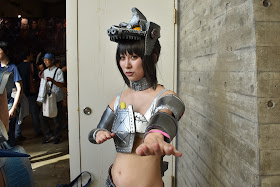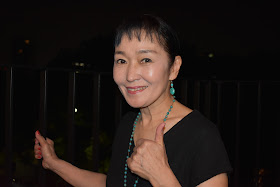Teruyoshi Nakano, Shigemitsu Taguchi, and Keiko Suzuki pose for pictures. Photo by Brett Homenick.
On Saturday, July 7, I was privileged to attend a rare screening of a 35mm print of Varan the Unbelievable (1958), which turns 60 this year. The print itself had obviously seen better days, as it was rather scratched up and jumpy. But given that I'd never seen a film print of the Japanese version before, it was nonetheless great to see.
Scripter Keiko Suzuki holds up her King Kong vs. Godzilla shooting script while Shigemitsu Taguchi looks on. Photo by Brett Homenick.
The event also celebrated SFX director Eiji Tsuburaya's birthday, so a few of his colleagues and contemporaries were on hand for the event. Keiko Suzuki was Toho's SFX scripter who worked alongside Eiji Tsuburaya for Toho's special effects spectaculars from the late 1950s through the end of the '60s. She brought her script for
King Kong vs. Godzilla, which contained storyboard images used during the shooting. That certainly made the audience take notice!
Also in attendance was Tsuburaya Productions scriptwriter Shigemitsu Taguchi, who is best known for his work writing episodes of the '70s Ultra-shows. He has also just written a book about Eiji Tsuburaya.
SFX director Teruyoshi Nakano. Photo by Brett Homenick.
Making his triumphant return was none other than SFX director Teruyoshi Nakano, who hadn't attended such an event in a few months. The audience was quite pleased to see Nakano-san again, who hasn't seemed to have lost a step.
After the movie, it was dinnertime! The conversation with Nakano-san was quite enlightening, as it always is. As hard as it is to see, Nakano-san once again confirmed that "about 30" octopuses were used in
King Kong vs Godzilla. He first mentioned this figure in my 2004 interview with him, and he said it again at an event in 2012. Given the possibility of translation errors, and since a much smaller number of octopuses has been reported elsewhere in English, I couldn't be quite sure. But he reiterated that number last night. And who would know better than Nakano-san himself?
Of his '70s films, he named
Godzilla vs. Mechagodzilla (1974) as his favorite. Most Americans would probably name
Terror of Mechagodzilla as their favorite.
Suffice it to say, it was another great event, and I couldn't think of a better way to celebrate the legacy of Eiji Tsuburaya. Can't wait to do it all over again!













































